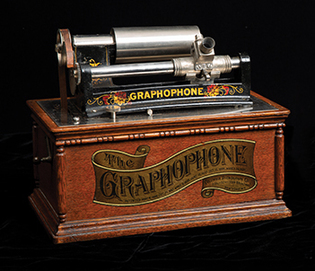
Nathan Utrup/Peabody Museum
The Graphophone, with its portable size—about 18 inches wide—and decorative paint and woodwork, is an example of how the phonograph evolved into a technology for entertainment as well as business. Its scroll-style label lists patent dates from 1886 to 1894.
The machine is one of many recording and playback devices in the Peabody’s History of Science and Technology collection.
View full image
In 1877, Thomas Edison invented the phonograph, the first device that could record and play back sound. In the 1800s, a number of people had experimented with using visual means to record sound, and some theorized about playing it back. Edison was the first to combine both functions, in the device he patented in 1878. The idea had emerged from his research on playing back telegram and telephone messages recorded as indentations on paper.
Edison’s first phonographs recorded sound on a thin sheet of metal, such as tinfoil, wrapped around a rotating, helically grooved cylinder. Someone would speak into a mouthpiece, and the sound would vibrate a diaphragm connected to a stylus. The vibrating stylus pressed the foil wrapper into the long groove around the rotating cylinder, recording the sound vibrations as variations in the depth of the impressions.
To play back the sound, the process was reversed: the stylus ran over the impressions in the foil and caused the diaphragm to vibrate. The vibrations, released as audible sound, could be amplified through a large horn.
The phonograph was demonstrated around the world, and the Edison Speaking Phonograph Company was established in 1878. However, Edison didn’t immediately focus on improving and commercializing the invention. He turned to other avenues of research, such as the incandescent lightbulb.
Many others jumped in to improve and commercialize the technology, helping to bring Edison’s technology into broader use. One of these individuals was Alexander Graham Bell, who had received his famous telephone patent in 1876. The French government awarded him a Volta Prize for the invention, allowing him to set up an electrical and acoustical laboratory in Washington, DC.
Bell’s investor and father-in-law, Gardiner Green Hubbard, was an investor in Edison phonographs as well. This led Bell and his Volta Laboratory to try to improve Edison’s invention, and they produced what they called the “Graphophone.” On one of the audio recordings made during research and development, Bell’s father quipped, “I am a Graphophone, and my mother was a phonograph.”
Volta Lab’s version of the phonograph was easier to operate and sounded better than Edison’s first designs. Bell and colleague Charles Sumner Tainter also developed a way to record and play back music on wax-coated cylinders, which were more durable than tinfoil-wrapped cylinders. They used a floating stylus rather than a rigid needle, and the stylus cut zigzag patterns into wax instead of making indentations in tinfoil. The Graphophone would be manufactured for decades, and many other phonograph makers adopted its key improvements.
The Volta Graphophone Company was created in 1886 to handle patenting and commercialization of audio inventions, including the Graphophone and later the dictaphone. (Bell and Tainter tried to collaborate with Edison, but he preferred to pursue improvements on his own—although he adopted Graphophone-style wax cylinders.) Over time, the trademark for the invention passed to a succession of companies, including the Columbia Phonograph Company. Columbia (later Columbia Records) manufactured the Graphophone pictured here.
By the 1890s, there were phonograph parlors in many cities where people could pay to listen to music, and they often overlapped with early motion-picture parlors. Phonographs gradually entered the domestic sphere as well, and manufacturers developed ways to produce cylinder recordings in larger numbers to meet the public demand.
The late Richard Warren Jr. curated the Historical Sound Recordings Collection at Yale’s Gilmore Music Library for 45 years. He transferred this Graphophone and other phonographs and dictaphones to the Peabody. They illustrate how the phonograph and its offspring revolutionized audio recording and playback.
These audio recorders and players also recorded momentous people and events. One of the devices Richard Warren transferred was a SoundScriber dictaphone made in New Haven. While Winston Churchill was visiting America in 1946, he used that machine to record an explanation of how he had composed all his speeches and publications for decades: by speaking into dictation machines. The machines preserved his famous words and his distinctive voice, with lines inscribed by a needle onto phonographic cylinders and discs.
 loading
loading